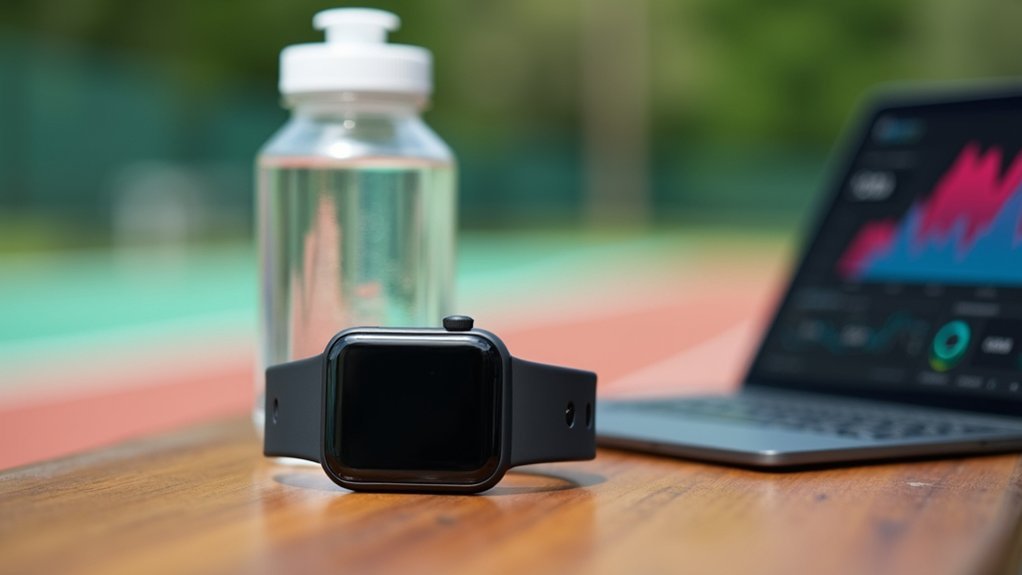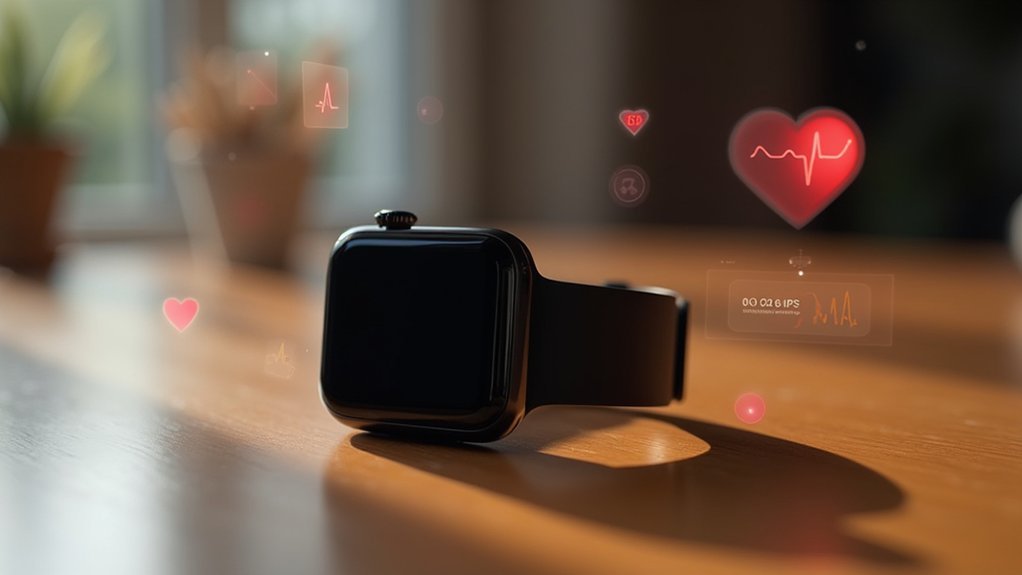When choosing a heart-monitoring GPS watch, prioritize accuracy by considering chest strap compatibility, as optical sensors can falter during intense workouts. Check real-world battery performance, not just advertised specs. Confirm GPS precision works in your environment (urban, forest). Evaluate display readability in various lighting conditions. Match water resistance to your activities. Examine the software ecosystem for valuable insights. Balance price against essential features rather than paying for extras you won’t use. The following tips will transform your selection process.
Prioritize Heart Rate Sensor Accuracy and Technology

When selecting a heart-monitoring GPS watch, the accuracy of its heart rate sensor should be your primary consideration. Understand that not all sensors are created equal: chest straps use electrical signals and offer superior accuracy, while wrist-based optical sensors are convenient but less precise during intense exercise.
Precision matters: chest straps deliver medical-grade heart data while optical sensors sacrifice accuracy for convenience.
For maximum accuracy, look for watches compatible with chest straps like the Polar H7, which maintains over 98% concordance with medical ECGs even during vigorous activity.
Among wrist-worn devices, Apple Watch Series III and later models lead the pack, showing minimal deviation from ECG readings. The Apple Watch Ultra 2 stands out for its industry-leading health metrics and exceptional accuracy. Consider that Garmin’s higher-end watches, despite their popularity, sometimes show significant discrepancies compared to chest straps.
Your training intensity matters too—optical sensors perform well at rest but may struggle above 8 mph running speeds.
Assess Battery Life Under Real-World Conditions
When evaluating GPS watches for heart monitoring, you’ll need to account for how battery life diminishes during intensive activities like dual-frequency GPS tracking.
You can extend your watch’s runtime by adjusting power settings, disabling unnecessary features, and choosing ideal GPS modes for different activities.
Solar-charging models like the Garmin Enduro 3 and Instinct 2X Solar offer significant advantages for outdoor enthusiasts, potentially extending battery life by weeks in smartwatch mode and hours during GPS tracking. The OnePlus Watch 2 utilizes a hybrid interface system that efficiently manages battery consumption while maintaining full smartwatch functionality.
Battery Drains During Activities
Although manufacturers advertise impressive battery specifications in ideal conditions, real-world performance during intense activities often tells a different story.
When you’re tracking exercises, battery drain varies dramatically based on which features you’re using. GPS is particularly power-hungry, especially in high-accuracy modes like dual-band or when combined with multiple satellite systems.
- Expect dramatic differences between smartwatch mode (15-90 days) and GPS tracking (24-320 hours), with dual-frequency GPS cutting battery life by more than half compared to standard GPS.
- Using continuous heart rate monitoring alongside GPS considerably increases power consumption, as demonstrated in marathon-a-day tests.
- Additional features like music streaming, AMOLED displays, and advanced physiological sensors compound battery drain, so prioritize watches with modes that match your specific activity needs.
Premium models like the Polar Grit X Pro offer significantly longer battery performance with up to 40 hours of GPS run time compared to more affordable options.
Optimize Power Settings
Optimizing your watch’s power settings ultimately determines whether your device lasts through an ultramarathon or dies halfway through your weekend hike.
Start by adjusting heart rate monitoring frequency—switching from continuous to 10-minute intervals can dramatically extend battery life.
Manage your display by reducing backlight brightness or setting it to manual activation.
Simplify data screens and limit notifications to prevent unnecessary wake-ups. COROS watches offer a battery usage tool that provides detailed breakdowns of what features are consuming the most power.
Most premium watches offer customizable battery profiles—use these to quickly switch between performance and endurance settings.
For maximum longevity during extended activities, adjust GPS sampling intervals and consider using airplane mode when connectivity isn’t needed.
Remember that multi-GNSS tracking (GPS+GLONASS) offers better accuracy but drains power faster than GPS-only mode.
These small adjustments can add hours to your watch’s runtime.
Solar Charging Benefits
Solar charging capabilities represent a game-changing advancement for GPS watches, offering extended battery life during outdoor activities when you need it most.
Don’t be misled by advertised battery claims—test your watch under real-world conditions that match your typical usage patterns.
- Track the daily battery percentage drop alongside your solar exposure hours to determine actual charging benefits
- Expect solar to slow battery drain rather than fully recharge—Garmin’s Forerunner 955 Solar offers 7 extra GPS hours compared to non-solar models
- Consider your outdoor activity profile—ultra-runners and hikers benefit considerably more than casual gym-goers
Remember that environmental factors dramatically impact solar efficiency. The Garmin Instinct 2 Solar requires 3 hours outside daily to maintain unlimited battery life in smartwatch mode.
While you won’t achieve “unlimited” battery life, solar charging can eliminate the need for portable chargers during multi-day adventures, providing peace of mind in remote locations.
Consider GPS Precision in Challenging Environments
When you’re tracking your heart rate during outdoor activities, the accuracy of your GPS watch can vary dramatically based on your surroundings.
Urban environments with tall buildings and forested areas with dense canopy pose the biggest challenges, causing underestimated distances and increased drift. To minimize these issues, it’s recommended to wait momentarily after acquiring GPS signal before starting your activity. You’ll get the most accurate readings in open spaces like track fields.
Garmin’s Fenix and Epix series and Polar watches typically offer superior precision, with error rates below 5% in various conditions.
Watches that support multiple satellite systems (GPS+GLONASS) provide better accuracy, with horizontal errors averaging around 7.1m compared to single-system devices.
Your activity also affects precision—running creates more GPS errors than walking or cycling, especially at faster speeds.
For reliable heart rate monitoring during workouts, prioritize watches with multi-GNSS support and proven performance in challenging environments.
Evaluate Display Readability Across Different Lighting

The display readability of your heart-monitoring GPS watch matters as much as its location accuracy, especially since you’ll need to check your heart rate data in various lighting conditions.
Consider the display technology carefully—transflective LCD and MIP displays excel in bright sunlight without draining battery, while OLED screens offer superior indoor visibility but struggle outdoors.
- Look for watches with high contrast ratios and maximum brightness levels (1000+ nits) to guarantee readability in direct sunlight.
- Choose models with anti-glare coatings and quality materials like Gorilla Glass or sapphire crystal to maintain clarity over time.
- Prioritize watches with customizable data screens and font sizes to optimize visibility during activities when quick glances are essential.
Larger screens with higher resolution display more data clearly, reducing eye strain during extended workouts. Some models like the Polar Pacer Pro feature a reflective display specifically designed to enhance visibility in bright environments.
Match Water Resistance Ratings to Your Activities
Water resistance ratings on heart-monitoring GPS watches often confuse buyers who mistakenly believe higher numbers automatically mean better protection for all activities.
In reality, these ratings indicate specific pressure tolerances under controlled conditions.
For everyday wear with occasional rain exposure or handwashing, a 3ATM watch suffices. If you’re a pool swimmer, don’t settle for less than 5ATM protection. Triathletes and ocean swimmers should invest in 10ATM models, while serious divers need specialized 20ATM watches. The Apple Watch Ultra 2 features an impressive 10 ATM rating and dive certification, making it ideal for water enthusiasts who need reliable protection.
Remember that no smartwatch is truly “waterproof”—all have limitations. Water resistance degrades over time, and exposure to chlorine, salt, or soap accelerates this process.
Always rinse your device with fresh water after aquatic activities to maintain its protective seals.
Examine Software Ecosystem and Training Analytics

Beyond physical durability, a heart-monitoring GPS watch’s true value lies in its software ecosystem and training analytics.
Look for watches that integrate seamlessly with your existing health apps through platforms like Apple’s HealthKit or Samsung’s Health ecosystem, enabling extensive data sharing with healthcare providers.
The best heart-monitoring watches offer:
- Clinical-grade ECG capabilities that detect irregularities like AFib while correlating cardiovascular response with exercise intensity and terrain
- Two-way data communication that combines heart metrics with GPS data to provide meaningful insights about your training load and recovery needs
- Exportable reports and cloud dashboards that visualize trends, allowing you to share detailed analytics with your healthcare team for personalized training adjustments
Leading devices like the Apple Watch have demonstrated strong correlations between their measurements and conventional medical devices for metrics such as SpO2 and heart rate.
Choose software that transforms raw heart data into actionable insights, helping you train smarter while safeguarding your cardiac health.
Balance Price Against Essential Feature Requirements
Finding the right balance between price and functionality remains one of the most challenging aspects of selecting a heart-monitoring GPS watch.
Consider your actual needs before splurging on premium models costing $800+ when mid-range options ($300-450) might serve you perfectly well.
Prioritize features that directly benefit your health monitoring goals—continuous heart rate tracking, abnormal heart rate alerts, and recovery metrics deliver more value than flashy extras.
If you’re budget-conscious, compromise on premium materials or AMOLED displays rather than core functionality.
For long-term value, look beyond initial price to factors like battery performance, durability, and firmware update history.
Remember that customizable battery modes can help you maximize battery life without sacrificing essential features, letting you tailor the watch’s performance to your specific activities.
For accurate health metrics during intense workouts, consider models that support chest strap monitors for more precise heart rate data than wrist-based sensors alone.
Frequently Asked Questions
Can These Watches Detect Irregular Heartbeats or Other Cardiac Conditions?
Yes, these watches can detect irregular heartbeats, primarily atrial fibrillation, through PPG sensors and ECG technology. They can’t detect heart attacks or complex arrhythmias though—they’re screening tools, not diagnostic devices.
How Accurate Are Sleep Tracking Features Compared to Medical Devices?
Consumer sleep trackers show high sensitivity (≥93%) detecting sleep but struggle with wake detection (specificity 0.18-0.54). You’ll get reasonable sleep/wake tracking, but medical devices remain superior for detailed sleep staging and clinical assessments.
Do Watches Work With Both Android and Ios Equally Well?
Most GPS watches work with both Android and iOS, but you’ll find varying compatibility. Apple Watches favor iOS, while brands like Garmin and Coros offer more balanced experiences across both platforms with minimal feature differences.
How Often Do These Watches Require Firmware Updates?
You’ll typically receive firmware updates for your heart-monitoring GPS watch every 3-6 months for major releases, with occasional minor patches in between. It’s important to install these to maintain accuracy and functionality.
Can Watch Bands Be Replaced With Standard Straps?
Yes, you can replace most GPS watch bands with standard straps. Check your watch’s lug width (typically 20-24mm) and look for quick-release options. Some brands use proprietary designs that limit your replacement choices.
In Summary
You’re investing in your health with a heart-monitoring GPS watch. Don’t settle for less than you need. Consider accuracy, battery life, GPS capabilities, display clarity, and water resistance that match your lifestyle. Choose a device with analytics that’ll help you progress, but don’t overpay for features you won’t use. The right watch becomes your trusted training partner—not just a gadget.





Leave a Reply